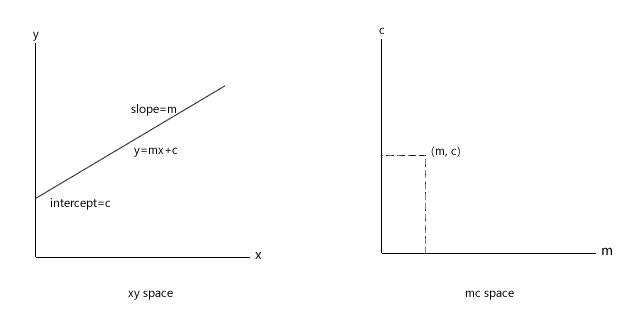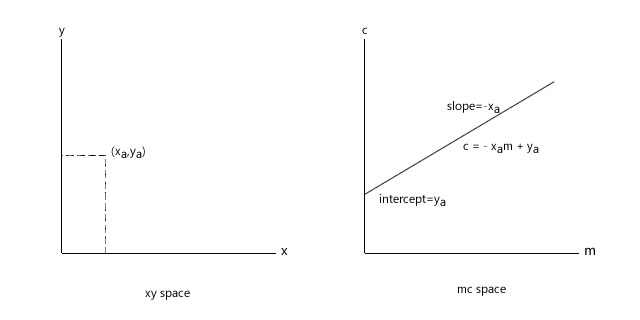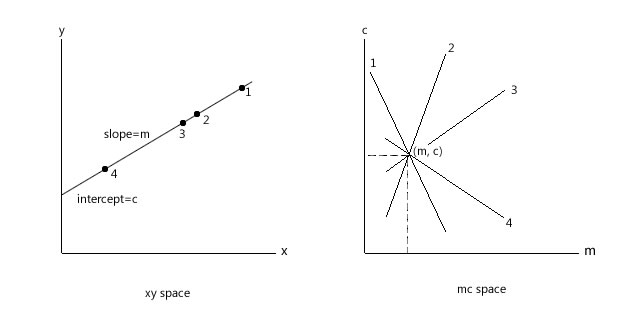霍夫变换基础知识-- The Hough Transform: Basics
来源:互联网 发布:淘宝买家信誉查询工具 编辑:程序博客网 时间:2024/04/30 14:30

The Hough Transform: Basics
The Hough transform is an incredible tool that lets you identify lines. Not just lines, but other shapes as well. In this article, I'll talk about the mechanics behind the Hough transform. It will involve a bit of math, but just elementary concepts you learned in school. In this article, we'll work with lines only, though the technique can be easily extended to other shapes.
Why the Hough Transform?
Lets say you take the snapshot of pole. You figure out edge pixels (using the Canny edge detector, the Sobel edge detector, or any other thing). Now you want a geometrical representation of the pole's edge.You want to know its slope, its intercept, etc. But right now the "edge" is just a sequence of pixels.
You can loop through all pixels, and some how figure out the slope and intercept. But that is one difficult task. Images are never perfect.
So you want some mechanism that give more weightage to pixels that are already in a line. This is exactly what the Hough Transform does.
It lets each point on the image "vote". And because of the mathematical properties of the transform, this "voting" allows us to figure out prominent lines in the image.
From lines to points
A lines is a collection of points. And managing a collection of points is tougher than managing a single point. Obviously. So the first thing we learn is how to represent a line as a single point, without losing any information about it.
This is done through the m-c space.

The m-c space
As shown in the above picture, every line has two quantities associated with it, the slope and the intercept. With these two numbers, you can describe a line completely.
So the parameter space, or the mc space was devised. Every line in the xy space is equivalent to a single point in the mc space. Neat eh?
From points to lines
Now onto the next step. Consider a point (say, (xa, ya) )in the xy space. What would its representation in the mc space be?
For starters, you could guess that infinite lines pass through a point. So, for every line passing through (xa, ya), there would be a point in the mc space.
And you're correct there, because of the following:
- Any line passing through (xa, ya): ya = mxa + c
- Rearranging: c = - xam + ya
- The above is the equation of a line in the mc space.
So, a point in the xy space is equivalent to a line in the mc space.

How does this help us?
The Hough transform is all about doing what we just learned: converting points in the xy space to lines in the mc space.
You taken an edge detected image, and for every point that is non black, you draw lines in the mc place. Obviously, some lines will intersect. These intersections mark are the parameters of the line.
The following picture will clarify the idea:

An example of houghlines
The points 1, 2, 3, and 4 are represented as various lines in the mc space. And the intersection of these lines is equivalent to the original line.
Great!
Now you know the basic idea of how the Hough transform works. But there's one big flaw in the We'll discuss how to resolve this issue in the next article.
from: http://aishack.in/tutorials/hough-transform-basics/
- 霍夫变换基础知识-- The Hough Transform: Basics
- 霍夫变换(Hough Transform)
- 霍夫变换(Hough Transform)
- 霍夫变换(Hough Transform)
- 霍夫变换(Hough Transform)
- 霍夫变换(Hough Transform)
- Hough transform霍夫变换
- 霍夫变换(Hough Transform)
- 霍夫变换(Hough Transform)
- Hough transform(霍夫变换)
- 霍夫变换(Hough Transform)
- 霍夫变换(hough transform)原理
- Hough Transform 霍夫变换检测直线
- 霍夫变换(Hough Transform)
- 霍夫变换(Hough Transform)直线检测
- 霍夫变换(Hough Transform)
- Hough Transform 霍夫变换检测直线
- Hough Transform 霍夫变换检测直线
- nginx+uwsgi+flask小例子
- 欢迎使用CSDN-markdown编辑器
- Harris角点检测: Harris Corner Detector
- Linux下把项目部署到tomcat
- postgre- 常用基本sql 语句
- 霍夫变换基础知识-- The Hough Transform: Basics
- Android自定义九宫格图案解锁
- 数据结构与算法——提供一个单词,在字典中找到它的兄弟
- OC中数组的基本操作
- Android 源码编译遇到的几个错误
- 霍夫变换的标准形式--The Hough Transform: Normal form
- 什么是PHP
- Java 异常处理
- 注解


